Pickle Recipes for Pickled Onions, Cucumbers, Beetroot ...
For those of you just starting out on pickling vegetables we suggest you visit our page on how to make pickles. There we have some step-by-step instructions on making pickles with pictures at each step.
We decided to choose one of our favorite way of pickling vegetables - pickled onions.
The way we prepare our pickled onions is dead easy, where we tell you how to peel your onions in such a way that we guarantee that when you have finished you wouldn't have shed a tear!
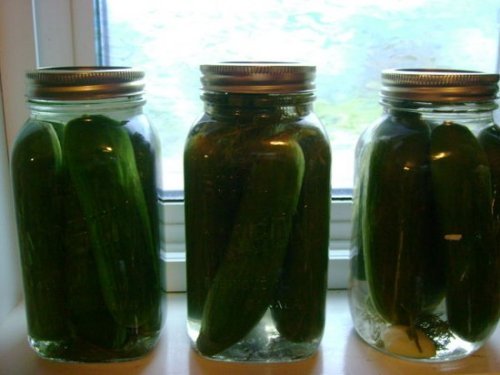
3 bottles of pickled cucumbers
PICKLE RECIPES for DILL PICKLES
Perhaps the most common pickles are pickled cucumbers. Pickled cucumbers make great additions to salads. The cucumbers selected should be small, so that they will be solid all the way through. If you are growing cucumbers at home, then you will have a ready supply for pickling.1 gal. water
4 c. coarse salt
200 small cucumbers
1/2 gal. vinegar
1-1/2 tsp. celery seed
1 lb. light-brown sugar
1/2 tsp. mustard seed
1 tsp. salt
1 oz. stick cinnamon
1 tsp. whole cloves
How to Make Dill Pickles: Make a brine of the water and the coarse salt, pour it over the cucumbers, and allow them to stand for 24 hours. At the end of this time, pour off the brine, wash the pickles in cold water, and place them into crocks. Heat the vinegar, add the celery seed, sugar, mustard seed, salt, cinnamon, and cloves, and bring the mixture to the boiling point. Pour this over the pickles in the crocks, cover closely while hot, and place in storage. If you prefer sweet cucumber pickles, add more brown sugar to the mixture.
PICKLE RECIPES USING SLICED-CUCUMBER
Large cucumbers cut into slices may be pickled in practically the same way as small cucumbers. At times, when small cucumbers are hard to get, large cucumbers will take their place very well. In fact, some prefer sliced cucumber pickles to the small ones.
PICKLE RECIPES for SLICED-CUCUMBER PICKLES
1 gal. sliced cucumbers1 c. coarse salt
1-1/2 qt. vinegar
1 pt. water
1 tsp. pepper
3 tsp. mustard
1 tsp. cinnamon
1 tsp. cloves
4 onions, chopped
1 c. brown sugar
1 Tb. salt
Select rather large cucumbers. Wash and peel them and cut into 1/4-inch slices. Sprinkle well with salt, and mix the salt among the layers of cucumbers. Allow this to stand for 24 hours; then drain and wash in clear cold water. To the vinegar and water add the spices, onion, sugar, and salt. Heat this to the boiling point, pour over the sliced cucumbers, and pack them into jars or crocks. Seal while hot and store.
PICKLE RECIPES for PICKLED CUCUMBERS IN BRINE
Cucumbers may also be preserved in brine, stored, and pickled in vinegar later in any quantity, as desired.
Pour 1 gallon of boiling water over 4 cupfuls of coarse salt. This should make brine that is heavy enough to support an egg. Wash cucumbers of any desired size, put them into a sterilized crock, in layers, and pour the brine, which has been allowed to cool, over the cucumbers until they are entirely covered. Cover the top of the crock well and store.Cucumbers preserved in this way may be taken from the brine at any time and pickled. To do this, soak them in fresh water to remove the salty taste. The fresh water may have to be poured off and replaced several times. After they have been freshened sufficiently, pickle them in vinegar and season them in any desirable way.
String beans that are pickled make a good relish to serve with meals. Unlike cucumbers that are pickled, the beans are cooked before the preserving liquid is added. The accompanying pickle recipe is for either wax or green beans.
Pickled Bean Recipe
4 qt. beans1-1/2 qt. vinegar
1 c. brown sugar
1 tsp. salt
1/2 tsp. pepper
1 tsp. allspice
1 tsp. cinnamon
1 tsp. cloves
Select large, firm, tender wax or green beans. Cover them with water to which has been added 1 level teaspoonful of salt to each quart and put them over the fire to cook. Boil the beans until they can be pierced with a fork, remove from the fire, drain, and pack into jars or crocks. To the vinegar add the sugar, salt, and spices. Bring this mixture to the boiling point, and pour it over the beans in the jars or crocks, filling them completely or covering the beans well. Close tight and store.
PICKLE RECIPES for PICKLED BEETS
Pickled beets meet with much favor as a relish. Like pickled beans, they must be cooked before they can be pickled; also, unless they are very small, they should be sliced before pickling as the recipe points out.Pickled Beet Recipe
4 qt. red beets2 qt. vinegar
2 c. brown sugar
1 tsp. salt
1/2 tsp. pepper
1 tsp. cinnamon
1 tsp. cloves
1 tsp. allspice
Cut the tops from the red beets, leaving 1 inch of the stems and the roots attached. Scrub well with a vegetable brush, and put to cook in boiling water. Cook until the beets are tender enough to be pierced with a fork. Pour off the hot water and run cold water over them. Remove the roots and stems, and cut into slices of any desired thickness or into dice, if preferred. Pack into jars or crocks. Then bring the vinegar to a boil, and to it add the sugar, salt, and spices. Pour this hot mixture over the beets. Seal the beets while hot, cool, and store.
PICKLE RECIPES for PICKLED CAULIFLOWER
Cauliflower is another vegetable that lends itself well to pickling. This food must be cooked, too, before pickling; and to have it just right for packing into the containers, it requires particular attention in cooking.Pickled Cauliflower Recipe
4 qt. cauliflower broken into pieces2 c. brown sugar
1 Tb. salt
1/2 tsp. pepper
1 qt. vinegar
1 pt. water
Select firm heads of cauliflower and break them into sections or flowerettes. Immerse these in cold water to which has been added 1 teaspoonful of salt to the quart. Allow the cauliflower to stand for 1 hour in the salt water. Remove from the water, and put over the fire to cook in salt water of the same proportion as that used for soaking.
Cook until the cauliflower is quite tender, but not so tender as it would be cooked to serve at the table. If this is done, the cauliflower will darken and break into pieces. It should be firm enough not to crush or break easily when it is packed into the jars. When properly cooked, pack closely into jars, add the sugar, salt, and pepper to the vinegar and water, heat to the boiling point, and pour this liquid over the cauliflower, completely covering it. Seal while hot, allow to cool, and store.
PICKLE RECIPES for PICKLED PEACHES
Among the fruits that may be pickled, peaches seem to meet with great favor. They, as well as pickled pears and pickled crab apples, make a relish that adds variety to the foods that are served in the home from day to day. The pickling process does not differ materially from that applied to vegetables, as the accompanying recipe shows.Pickled Peaches Recipe
2 lb. brown sugar1 qt. vinegar
1 oz. stick cinnamon
4 qt. peaches
2 Tb. cloves
Boil the sugar, vinegar, and cinnamon together until they begin to look sirupy. Wash the peaches and rub off the fuzz. Stick one or two cloves into each peach, and drop the peaches into the sirup. Cook them until they may be easily pierced with a fork. Put them into jars, pour the sirup over them, filling each jar, and seal while hot. Allow the jars to cool and store. The peaches may be peeled if desired. It may also be more convenient to cook only part of the peaches in the sirup at one time, cooking the remainder after these have been taken out and put into jars.
PICKLE RECIPES for PICKLED PEARS
Pears also lend themselves readily to pickling. Specific directions are not given here, because they are pickled in exactly the same way as peaches. The pears may be peeled or not, as desired.PICKLE RECIPES for CRAB APPLES
Crab apples that are to be pickled should preferably be of a large variety. The directions given for pickling peaches apply also to this fruit. The crab apples should be examined carefully to make certain that they contain no worms. Also, the stems should be left on, and they should be washed thoroughly with the blossom ends cut out.Extra Resources on Making Pickles:
Go to Canning Recipes
Home Canning
If you have anything you would like to add to the Pickle Recipes page, feel free!
Leave a Comment
Do you have anything that you would like to add after reading this page? We would love to hear your thoughts. If you can add additional information to what has been written here you will be adding value to the website! No need to have any special skills - just type and submit. We will do the rest!



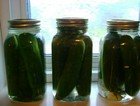
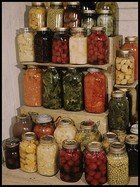

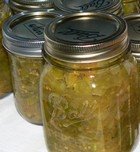
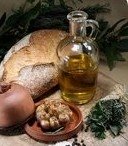
New! Comments
Do you have something of value to add? Leave me a comment in the box below.